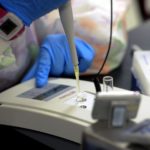UWF scientist looks to unravel a different kind of mystery on Easter Island
The stone heads of Rapa Nui, or Easter Island, have baffled anthropologists and historians for centuries.

The island, which sits more than 2,000 miles off the coast of Chile, is the most isolated place on earth still inhabited by humans. Its geography is littered with the heads, some of them as tall as 30 feet and weighing as much as 80 tons, the work of an advanced civilization that flourished and failed long ago.
To this day, researchers can’t agree what, exactly, happened to those ancient sculptors. The mystery of their demise has drawn inquiring minds to this isolated outpost for centuries, but it’s a different, much less conspicuous question that has drawn Dr. Wade Jeffrey.
Jeffrey, a microbial biologist, directs the Center for Environmental Diagnostics and Bioremediation at the University of West Florida. He is part of an international team of researchers trying to understand how the world’s changing climate might impact the ecology of the island.
To do that, they are focusing, not on the monumental, but the minute.
Easter Island is located in the South Pacific Gyre, an “oceanic desert” that is the largest and least-productive ecosystem in the South Pacific. The island is one of few biological hot spots in this nutrient-starved region of the sea.
“The question we’re trying to understand as microbial ecologists is, at the bottom of the food web, where the bacteria are, what controls bacterial growth before, up to and around this hot spot,” Jeffrey said. “What controls the productivity around these hot spots? We know they’re there, but we don’t really know how they create this increase in productivity.”
Jeffrey is a co-investigator on the project, following the lead of Dr. Klaudia Hernandez, from the Universidad Andres Bello, in Quintay, Chile.
Hernandez and a team of researchers will embark on a month-long expedition in October, traveling from Chile to Easter Island to collect water samples that will later be analyzed by Jeffrey.
“We’ll look at growth,” Jeffrey said. “We’ll look at biomass. We’ll look at diversity.”
Jeffrey said the work could help researchers understand how climate change might impact the island’s fragile ecosystem.
“There’s some evidence that, because of warming oceans, the South Pacific Gyre is actually increasing in size,” Jeffrey said. “It’s possible if the water really warms, if the gyre gets bigger, that the productivity around the island could change, as well.”
Those lessons might have implications beyond the island, he added.
“Easter Island is really cool because it’s pretty isolated,” Jeffrey said. “Scientifically, it’s nice to deal with only one thing at a time. The simpler a system is, the easier it is to tease apart the causes and effects, and, if you tease apart the causes and effects in a simple system, you might be able to apply that to a more complex system down the line, too.”
The team’s work is being funded through a $20,000 grant from the Chilean Center for Marine Instruction and Training. None of that money will actually flow through UWF. However, Jeffrey hopes the study might increase the likelihood that a larger, follow-up proposal would be funded, as well.
That grant, also through the Chilean government, would fund a three-year research plan that would likely involve student researchers from UWF.
Jeffrey will not be accompanying Hernandez on the Easter Island expedition, though he will travel to Chile later this month to transport some equipment to the research team and train them in its operation. He will return to Chile in October for a separate research project, examining microbial diversity in the nation’s high-desert salt springs. That will be his sixth time visiting the country, which he described as a goldmine for microbial research because of its extreme ecological diversity.
“If you’re interested in how microbes are able to adapt and evolve to be able to thrive in these really weird places, it’s a great place to go,” he said.


